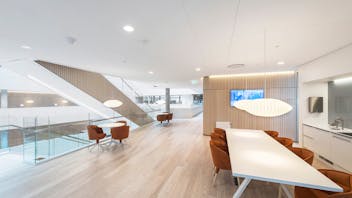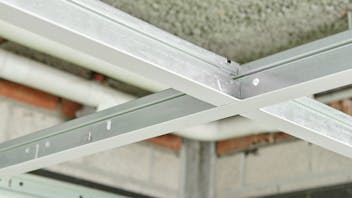Ceiling tile light reflectance and overall light can have a profound impact on our wellbeing and mood. Too much light can cause eyestrain and make it hard to focus. Too little can lead to headaches, lack of focus and drowsiness.
Our white, acoustic stone wool ceiling panels reflect up to 86 percent of all available light, dispersing natural light more effectively. As part of a suspended ceiling system, they diffuse light to limit hot spots and glare so that shining spots do not disturb the eye.
Because of this high light reflectance, energy efficiency also is enhanced. The better distribution of light means it’s possible to lower the light loads and reduce cooling costs by up to 7 percent. Maximizing the use of natural light also reduces the number of light fixtures required, which can translate into greater savings.
These combined benefits can greatly contribute to the performance of the space and the people within it.
What is light reflectance?
Light reflectance (LR) indicates the percentage of light that ceilings reflect. Our stone wool ceiling tiles and products feature a smooth or lightly textured, homogenous surface. Our selection of white acoustic ceiling products ranges in LR from 0.83 to 0.86. This means that 83-86 percent of the light beam that strikes the ceiling panel will be reflected, regardless of the light source.
Direct light means an object is hit directly with the beam, whereas indirect light is the result of a reflection. Because the ceiling is the only surface in a room that is completely visible, select a high LR to make effective use of both natural and electric light sources.
The power of natural light
Light is vital to human functioning and plays an important role in both our psychological and physiological condition. Beyond aiding vision, light has a direct effect on the areas of our brain, which act as a stimulant to keep us alert and able to perform better cognitively.
In a recent study highlighting important trends within the building industry, "Smart Market Report 2016" Dodge Data & Analytics identified access to daylight as a key feature for healthier buildings. Of the survey’s respondents, 60 percent identified daylight as a feature that will remain on the healthy building agenda1.
The U.S. Green Building Council’s LEED v4 rating system recognizes the power of natural light as part of the Interior Lighting credit under Lighting Quality, which allows designers to demonstrate compliance by identifying four specific strategies from a list of eight provided. Several of these strategies identify specific average surface reflectance levels of 85 percent for ceilings, among other things, over 90 percent of the regularly occupied floor area. Our stone wool ceiling tiles are readily available to help your projects meet or exceed this level.
Sources
1. https://www.construction.com/toolkit/reports/drive-toward-healthier-buildings


















